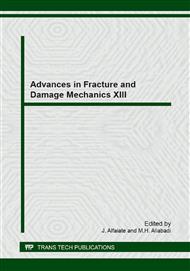p.33
p.37
p.41
p.45
p.49
p.53
p.57
p.61
p.65
Modelling Mixed-Mode Fracture Using an Energy-Based Damage Model
Abstract:
In this work, a new damage model for mixed-mode fracture in the scope of the discrete crack approach is introduced. An energy-based internal damage variable is adopted. In the model, deformation-driven loading surfaces are defined and the dual loading surfaces in the traction space are derived. Under proportional loading, it is found that the constitutive relationship is symmetric. Further enrichment of the energy-based variable on the traction field is also introduced, allowing for a better approximation of: i) the limit surface defined in traction space and ii) non-proportional loading. However, in this case symmetry of the constitutive tensor is lost.
Info:
Periodical:
Pages:
49-52
Citation:
Online since:
September 2014
Authors:
Price:
Сopyright:
© 2015 Trans Tech Publications Ltd. All Rights Reserved
Share:
Citation:


